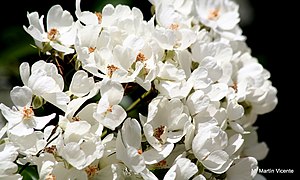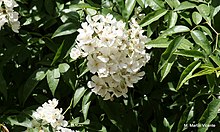Rosa cymosa
| Rosa cymosa | ||||||||||||
|---|---|---|---|---|---|---|---|---|---|---|---|---|

Rosa cymosa var. Cymosa |
||||||||||||
| Systematics | ||||||||||||
|
||||||||||||
| Scientific name | ||||||||||||
| Rosa cymosa | ||||||||||||
| Tratt. |
Pink cymosa is a plant from the genus roses ( Rosa ) within the family of the rose family (Rosaceae). It is common in Laos , Vietnam , Taiwan and China.
description
Appearance and leaf
Rosa cymosa grows as an evergreen, climbing or climbing shrub and reaches heights of 2 to 5 meters. The stem-round twigs have a bare or downy hairy bark . The scattered spines are up to 6 millimeters long, hooked, flat and gradually taper towards their base. The vegetative parts of the plant can be sparse in Rosa cymosa var. Cymosa and densely haired in Rosa cymosa var. Puberula .
The alternately arranged leaves are divided into petioles and leaf blades and a total of 5 to 10 centimeters long. The leaf blade in unpaired pinnate with mostly three or five, rarely seven pinnate leaves. The petiole and the leaf hachis are hairy bald to downy, often sparsely prickly, rarely hairy glandular or downy. The leathery leaflets are 2.5 to 6 centimeters long and 0.8 to 2.5 centimeters wide and are ovate-lanceolate to elliptical with a slightly rounded base and a pointed upper end. The surfaces of the pinnate leaves are pink cymosa var. Cymosa glabrous on both sides and finely hairy on the underside along the raised central veins or, in the case of Rosa cymosa var. Puberula, densely hairy on both sides. The top of the leaflets is glossy and the edge is serrated to a point. The two early-falling, membranous stipules are free, linear with a pointed upper end and a smooth edge.
Inflorescence and flower
Many flowers are in compound, umbrella- clustered inflorescences that have a diameter of 20 to 25 centimeters. The approximately 1.5 centimeter long flower stalks are initially hairy and then bald. The bracts are lanceolate with a pointed upper end and a sparsely glandular-downy hairy margin.
The flowering time in China is between May and June. The hermaphrodite, fragrant flowers are radially symmetrical and five-fold with a double flower envelope . The bare flower cup (hypanthium) is spherical or egg-shaped. The five early falling sepals are egg-shaped with a pointed upper end and often a pinnately lobed edge, almost bare on the underside, rarely bristly hairy and sparse, white woolly hairy on the upper side. The five free white, cream-colored to yellow petals are obovate with a wedge-shaped base and an edged upper end. The stamens are almost as long as the petals. The free, dense white hairy style protrudes slightly over the petals.
fruit
The rose hips, which are red, scarlet, black-brown to black when ripe, are relatively small and spherical with a diameter of 4 to 7 millimeters. The rose hips ripen in China from July to November.
Systematics and distribution
The first description of Rosa cymosa was made in 1823 by Leopold Trattinnick in Rosacearum Monographia , Volume 1, page 87. synonyms for Rosa cymosa Tratt. are: Rosa amoyensis Hance , Rosa banksiae var. microcarpa Regel , Rosa bodinieri H.Lév. & Vaniot , Rosa cavaleriei H.Lév. , Rosa chaffonjonii H.Lév. & Vaniot , Rosa esquirolii H.Lév. & Vaniot , Pink fukienensis F.P.Metcalf , Rosa indica L. , Rosa microcarpa Lindl. Focke , Rosa sorbiflora .
Rosa cymosa belongs to section Banksianae from the subgenus Rosa in the genus Rosa .
From Rosa cymosa there since 2006 three varieties:
- Rosa cymosa Tratt. var. cymosa : It is common in Laos , Vietnam , Taiwan and China. In China, it thrives on hills, open slopes, on the banks of rivers and on roadsides at altitudes of 200 to 1800 meters in the provinces of Anhui , Fujian , Guangdong , Guangxi , Guizhou , Hunan , Jiangsu , Jiangxi , Sichuan , Yunnan and Zhejiang .
- Rosa cymosa var. Dapanshanensis F.G.Zhang : It was first described in 2006 from the Chinese province of Zhejiang.
- Rosa cymosa var. Puberula T.T.Yu & TCKu : It occurs in Huang Shan in southern Anhui, in Wuchang County in eastern Hubei, in Pukou in western Jiangsu, and in Lantian County in southern Shaanxi.
use
The relatively small rose hips are used raw or cooked. Only a relatively thin, fleshy layer that surrounds the many seeds can be used. You have to be very careful that all seed hairs are thoroughly removed to avoid irritation in the mouth and digestive tract. The seeds are a good source of vitamin E. The seeds can be ground into flour, mixed with other types of flour, or added to food.
The medical effects have been investigated and alleviations have been demonstrated in a variety of diseases.
It is used as an ornamental plant, for example in Chinese tea plantations . It thrives in USDA climate zone 8 and survives down to lows of -10 ° C; in areas with more severe frosts it could be grown in greenhouses.
swell
- Gu Cuizhi, Kenneth R. Robertson: Rosa : Rosa cymosa , p. 379 - online with the same text as the printed work , In: Wu Zheng-yi & Peter H. Raven (Eds.): Flora of China , Volume 9 - Pittosporaceae through Connaraceae , Science Press and Missouri Botanical Garden Press, Beijing and St. Louis, 2003. ISBN 1-930723-14-8
Individual evidence
- ↑ a b c d e f g h i Gu Cuizhi, Kenneth R. Robertson: Rosa : Rosa cymosa , p. 379 - online with the same text as the printed work , In: Wu Zheng-yi & Peter H. Raven (ed.): Flora of China , Volume 9 - Pittosporaceae through Connaraceae , Science Press and Missouri Botanical Garden Press, Beijing and St. Louis, 2003. ISBN 1-930723-14-8
- ↑ Rosa cymosa at Tropicos.org. Missouri Botanical Garden, St. Louis, accessed March 1, 2015.
- ↑ Rosa cymosa in the Germplasm Resources Information Network (GRIN), USDA , ARS , National Genetic Resources Program. National Germplasm Resources Laboratory, Beltsville, Maryland. Retrieved March 1, 2015.
- ↑ Jingyun Fang, Zhiheng Wang, Zhiyao Tang: Atlas of Woody Plants in China: Distribution and Climate . tape 1 . Springer, 2011, ISBN 978-3-642-15017-3 ( distribution map of Rhododendron racemosum on page 554 in the Google book search).
- ↑ Zhang Fanggang, Jin Xiaofeng, Wei Fumin: Rosa cymosa var. Dapanshanensis, a new variety of rosaceae from Zhejiang, China. In: Acta Botanica Yunnanica , Volume 28, Issue 6, 2006, p. 606.
- ↑ a b Rosa cymosa at Plants For A Future . Retrieved March 1, 2015.
- ↑ Data sheet from Rogers Roses . ( Memento of the original from December 26, 2015 in the Internet Archive ) Info: The archive link was inserted automatically and has not yet been checked. Please check the original and archive link according to the instructions and then remove this notice.
literature
- Heinrich Schultheis: Roses: the best kinds and sorts for the garden , Ulmer, Stuttgart 1996, ISBN 3-8001-6601-1
- Roger Phillips and Martyn Rix: Rosarium - Ulmer's large rose book - The best varieties for the garden and winter garden , Eugen Ulmer Verlag, Stuttgart 2005, ISBN 3-8001-4776-9
